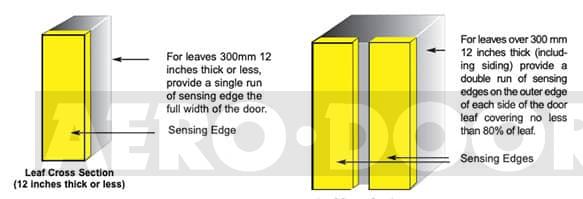What is a sensing edge / safety bumper?
The primary goal is to stop the movement of the hangar door before it comes in to contact with an aircraft, a tug, or something else. The sensing edge is a PVC coated bumper that goes on the leading and trailing edge leave(s) on a steel sliding hangar door.
Inside the bumper is a contact switch that activates under slight pressure, this sends an electrical signal back to the motor and controls to stop and/or reverse the door.

Sensing Edge Specifications
Colors: Gray, yellow, black, white, yellow/black striping.
Sensitivity: 15 Pounds of force.
Cover: Heavy duty reinforced.
Mounting: Mounts to the leading and trailing edge door panels.
Care & Maintenance
Minimum care is required for a sensing edge safety bumper, since they are manufactured with only the most durable materials and highest quality standards.
However, it is strongly recommended that you observe good maintenance practices by including a check of the entire length of the sensing edges at least once per month for any signs of damage, cuts, loss of sensitivity or water damage.
Also check all of the wiring and be sure all connections are secure. If you think there may be a damaged edge or component, do not attempt to adjust them, just contact AeroDoor.
The 3 Types of Sensing Edges
There are 3 primary choices, each with their own important considerations.
2-Wire Sensing Edge
The 2-wire electric sensing edge consists of two (2) adjacent conductive strips inside an astragal that is attached on the bottom of a motor driven door. These strips are normally separated by a small gap, and are connected to the control circuit of the motor operator.
When the astragal is compressed, the conductive strips make contact activating the sensing edge. In the event that the conductive strip(s) become broken, the section of the sensing edge beyond the break will cease to function.
In the event that the conductive strip(s) become broken, the section of the sensing edge beyond the break will cease to function. As the operator you will have no way of knowing this without physical inspection of the sensing edge.
4-Wire Fail Safe Sensing Edge
4-Wire is also known as a “Fail-Safe” edge, with the term fail-safe designating that the door will revert to manual operation in the event of a continuity loss within the circuit.
The 4-wire electric sensing edge operates the same as a two-wire electric sensing edge with the exception that it is designed to function with self-monitoring circuitry. This circuitry will prevent the motor operator from closing the door when a fault is detected, e.g. a conducting strip is broken or a wire is open, requiring manual operation to close the door.
Pneumatic Sensing Edge
The pneumatic Sensing Edge is a flexible astragal or weather seal attached to the bottom of the door with a rubber or plastic tube inside the full length of the astragal.
A plug seals one end of the tube and the other end is attached to a pneumatically activated electric switch that is connected to the control; circuit of the motor operator for the door. When the door closes on an obstruction, the pressure in the tube increases and activates the electric switch.
Installation & Availability
- Sensing edge should be applied to each leading and trailing edge door leaf.
- The lowest 5ft of the sensing edge should be manufactured to be removable for convenience in servicing or repair.
- We recommend that hangar door leaves 12″ thick or less should have a single run of sensing edge. For door leaves over 12″ thick we recommend a double run of sensing edge covering no less than 80% of the door leaf.

AeroDoor offers nationwide supply and installation of sensing edges on new or existing steel sliding hangar door
Paul has over 14-years of sales and marketing experience in the hangar door industry. Prior to this, Paul spent 8 years working in a sales division of Apple Inc, where skills in supply chain, selling and customer service were taught at a multinational level.


